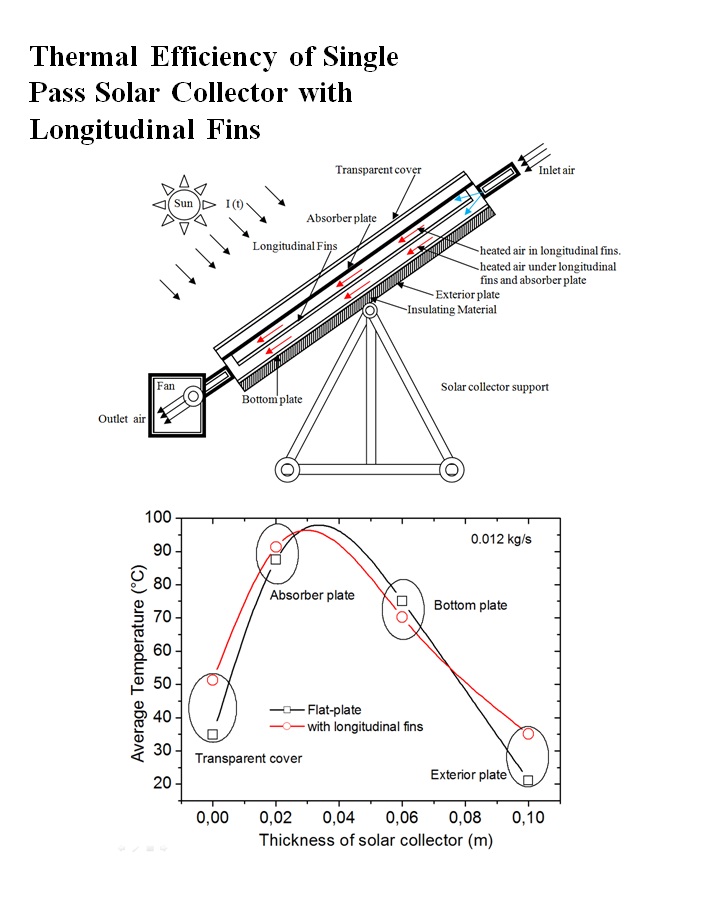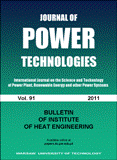Experimental analysis on thermal performance of a solar air collector with longitudinal fins in a region of Biskra, Algeria
Abstract
This paper presents a thermal performance of a single pass solar air heater with fins attached was investigated experimentally. Longitudinal fins were used inferior the absorber plate for an increase the heat exchange and uniform the flow fluid in the channel. The effects of mass flow rate of air on the outlet temperature, the heat transfer in a thickness of solar collector and thermal efficiency were studied. Experiments were performed for two air mass flow rates of 0.012 kg/s., Moreover; the maximum efficiency was obtained by using five longitudinal fins and without fins. The maximum efficiency obtained for the 0.012 kg/s with and without fins were 40.02 % and 34.92 %, respectively. Comparison of the results as an effect the solar collector’s with and without fins shows a substantial enhancement in the thermal efficiency.References
References
[1] Garg H.P., Adhikari R.S.: Performance evaluation of a single solar air heater with n-subcollectors connected in different combinations. International Journal of Energy Research 23,1999,pp. 403–414.
[2] Belusko M., Saman W., Bruno F.: Performance of jet impingement in unglazed air collectors. Solar Energy 82, 2008, pp.389–398.
[3] Duffie J.A., Beckman W.A.: Solar Engineering of Thermal Processes, Wiley, New York, 1991.
[4] Koyuncu T.: Performance of various design of solar air heaters for crop drying applications. Renewable Energy 31, 2006, pp.1073–1088.
[5] Yeh H.M., Lin T.T.: The effect of collector aspect ratio on the collector efficiency of flat-plate solar air heaters. Energy 20, 1995, pp.1041–1047.
[6] Yeh H.M., Ho C.D., Hou J.Z.: Collector efficiency of double-flow solar air heaters with fins attached, Energy 27 (2002) 715–727.
[7] Othman Mohd.Y.Hj., Yatim B. , Sopian K., Abu Bakar Mohd.N.: Performance analysis of a double-pass photovoltaic/thermal (PV/T) solar collector with CPC and fins. Renewable Energy 30, 2005, pp.2005–2017.
[8] Hachemi A.: Thermal performance enhancement of solar air heaters, by a fan-blown absorber plate with rectangular fins. International Journal of Energy Research 19, 1995, pp.567–578.
[9] Yeh H.M., Ho C.D., Lin C.Y.: Effect of collector aspect ratio on the collector efficiency of upward type baffled solar air heaters. Energy Conversion and Management 4, 2000, pp. 971–981.
[10] L. Goldstein Jr., Sparrow E.M.: Experiments on the transfer characteristics of a corrugated fin and tube heat exchanger configuration. Journal of Heat Transfer 98, 1976, pp. 26–34.
[11] Gao W.F., Lin W.X., Liu T., Xia C.: Analytical and experimental studies on the thermal performance of cross-corrugated and flat-plate solar air heaters. Applied Energy 84, 2007, pp.425–441.
[12] Ho C.D., Yeh C.W., Hsieh S.M.: Improvement in device performance of multi-pass flat-plate solar air heaters with external recycle. Renewable Energy 30, 2005, pp.1601–1621.
[13] Romdhane B.S.: The air solar collectors: Comparative study, Introduction of baffles to favor the heat transfer. Solar Energy 81, 2007, pp.139–149.
[14] Omojaro A.P., Aldabbagh L.B.Y.: Experimental performance of single and double pass solar air heater with fins and steel wire mesh as absorber. Applied Energy 87, 2010, pp.3759–3765.
[15] Hachemi A.: Experimental study of thermal performance of offset rectangular plate fin absorber-plates. Renewable Energy 17, 1999, pp.371–384.
[16] McAdams W.H.: Heat Transmission, McGraw-Hill, New York, 1954.
[17] Klein S.A.: Calculation of flat-plate loss coefficients. Solar Energy 17, 1975, pp.79–80.
[18] Karsli S.: Performance analysis of new-design solar air collectors for drying applications. Renewable Energy 32, 2007, pp.1645–1660.
[19] Kurtbas I., Durmus A.: Efficiency and exergy analysis of a new solar air heater. Renewable Energy 29, 2004, pp.1489–501.
[20] Esen H.: Experimental energy and exergy analysis of a double-flow solar air heater having different obstacles on absorber plates. Building and Environment 43, 2008, pp.1046–1054.
[21] Azad E.: Design installation and operation of a solar thermal public bath in eastern Iran. Energy for Sustainable Development 16, 2012, pp.68–73.
[1] Garg H.P., Adhikari R.S.: Performance evaluation of a single solar air heater with n-subcollectors connected in different combinations. International Journal of Energy Research 23,1999,pp. 403–414.
[2] Belusko M., Saman W., Bruno F.: Performance of jet impingement in unglazed air collectors. Solar Energy 82, 2008, pp.389–398.
[3] Duffie J.A., Beckman W.A.: Solar Engineering of Thermal Processes, Wiley, New York, 1991.
[4] Koyuncu T.: Performance of various design of solar air heaters for crop drying applications. Renewable Energy 31, 2006, pp.1073–1088.
[5] Yeh H.M., Lin T.T.: The effect of collector aspect ratio on the collector efficiency of flat-plate solar air heaters. Energy 20, 1995, pp.1041–1047.
[6] Yeh H.M., Ho C.D., Hou J.Z.: Collector efficiency of double-flow solar air heaters with fins attached, Energy 27 (2002) 715–727.
[7] Othman Mohd.Y.Hj., Yatim B. , Sopian K., Abu Bakar Mohd.N.: Performance analysis of a double-pass photovoltaic/thermal (PV/T) solar collector with CPC and fins. Renewable Energy 30, 2005, pp.2005–2017.
[8] Hachemi A.: Thermal performance enhancement of solar air heaters, by a fan-blown absorber plate with rectangular fins. International Journal of Energy Research 19, 1995, pp.567–578.
[9] Yeh H.M., Ho C.D., Lin C.Y.: Effect of collector aspect ratio on the collector efficiency of upward type baffled solar air heaters. Energy Conversion and Management 4, 2000, pp. 971–981.
[10] L. Goldstein Jr., Sparrow E.M.: Experiments on the transfer characteristics of a corrugated fin and tube heat exchanger configuration. Journal of Heat Transfer 98, 1976, pp. 26–34.
[11] Gao W.F., Lin W.X., Liu T., Xia C.: Analytical and experimental studies on the thermal performance of cross-corrugated and flat-plate solar air heaters. Applied Energy 84, 2007, pp.425–441.
[12] Ho C.D., Yeh C.W., Hsieh S.M.: Improvement in device performance of multi-pass flat-plate solar air heaters with external recycle. Renewable Energy 30, 2005, pp.1601–1621.
[13] Romdhane B.S.: The air solar collectors: Comparative study, Introduction of baffles to favor the heat transfer. Solar Energy 81, 2007, pp.139–149.
[14] Omojaro A.P., Aldabbagh L.B.Y.: Experimental performance of single and double pass solar air heater with fins and steel wire mesh as absorber. Applied Energy 87, 2010, pp.3759–3765.
[15] Hachemi A.: Experimental study of thermal performance of offset rectangular plate fin absorber-plates. Renewable Energy 17, 1999, pp.371–384.
[16] McAdams W.H.: Heat Transmission, McGraw-Hill, New York, 1954.
[17] Klein S.A.: Calculation of flat-plate loss coefficients. Solar Energy 17, 1975, pp.79–80.
[18] Karsli S.: Performance analysis of new-design solar air collectors for drying applications. Renewable Energy 32, 2007, pp.1645–1660.
[19] Kurtbas I., Durmus A.: Efficiency and exergy analysis of a new solar air heater. Renewable Energy 29, 2004, pp.1489–501.
[20] Esen H.: Experimental energy and exergy analysis of a double-flow solar air heater having different obstacles on absorber plates. Building and Environment 43, 2008, pp.1046–1054.
[21] Azad E.: Design installation and operation of a solar thermal public bath in eastern Iran. Energy for Sustainable Development 16, 2012, pp.68–73.

Published
2013-03-18
How to Cite
CHABANE, Foued; MOUMMI, Noureddine; BENRAMACHE, Said.
Experimental analysis on thermal performance of a solar air collector with longitudinal fins in a region of Biskra, Algeria.
Journal of Power Technologies, [S.l.], v. 93, n. 1, p. 52--58, mar. 2013.
ISSN 2083-4195.
Available at: <https://papers.itc.pw.edu.pl/index.php/JPT/article/view/369>. Date accessed: 07 june 2025.
Issue
Section
Renewable and Sustainable Energy
Keywords
Solar intensity, Solar air collector, Heat transfer, Design, Temperature.
Authors who publish with this journal agree to the following terms:
- Authors retain copyright and grant the journal right of first publication with the work simultaneously licensed under a Creative Commons Attribution License that allows others to share the work with an acknowledgement of the work's authorship and initial publication in this journal.
- Authors are able to enter into separate, additional contractual arrangements for the non-exclusive distribution of the journal's published version of the work (e.g., post it to an institutional repository or publish it in a book), with an acknowledgement of its initial publication in this journal.
- Authors are permitted and encouraged to post their work online (e.g., in institutional repositories or on their website) prior to and during the submission process, as it can lead to productive exchanges, as well as earlier and greater citation of published work (See The Effect of Open Access).


